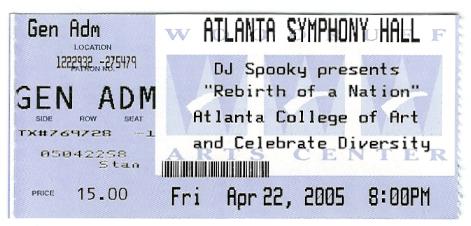23 April 2005
Review: Rebirth of a Nation

I felt like I was at the East Side Lounge: listening to DJ music and watching art film collage. Even though "stylish" is not a just criticism of art, I'm struggling to find intent or meaning in DJ Spooky's [Wikipedia] Rebirth of a Nation beyond its style. And with a format as strenuous to the viewer as it was, there should be more of an intellectual or emotional payoff.
Rebirth of a Nation, in Spooky's words from the evening, "uses DJ techniques to remix the original movie" The Birth of a Nation [Wikipedia]. The soundtrack consisted of DJ Spooky's music with some source material from blues musician Robert Johnson [Wikipedia]. I had no previous experience with The Birth of a Nation. Although I had heard of it, I had never seen it, and what I had read was mostly from reviews of Rebirth of a Nation. I enjoyed the framing of many of the scenes that were taken from the original. However, the over-acting that's found in silent films paired with the costumes of the Ku Klux Klan evinced more comedy than dread or shame. (Those pointy hoods aren't standing up from an excess of starch. Apparently, the wearer had a helmet with a tall pole attached to tent the material. In the film, clan members usually would forego the hood and wear just the helmet with a cloth covering their faces. They looked like an army of horse-riding unicorn men.)
Spooky cut-and-pasted sections of the film across the screens: one larger and two slightly smaller framing it on either side. The smaller screens often contained the material from the main screen delayed by several minutes. At times, the three screens would contain related images, but such coincidences held little more interest than what was already provided by the repetition of themes in the source material. Until late into the show, the quoted film segments proceeded in what appeared to be the same narrative sequence as the original movie. This produced one of the main problems for Rebirth: viewers were compelled to look past his edits in order to follow the original story. This problem is similar to the inclusion of text in a painting. Viewers will read the text and ignore the content of the visual imagery. Examples of successful borrowing are the cubist collages that include only fragments of text--the letters become shapes that are absorbed into the visual framework. The framework of Rebirth is as much the source material as it is the new edits.
I hoped to create a counter-narrative, one where the story implodes on itself, one where new stories arise out the ashes of that explosion.
Beyond scene edits and juxtapositions, DJ Spooky's primary additions were repeated overlays to the scenes and the addition of several video effects. The overlays included a grid, an expanding circuit board, and various building blueprints. Again, these were little more than decorations to the original movie. The circuit boards often appeared in violent scenes, but with so much violence in the original film I'm not sure that this pairing was planned or accidental. And if planned, I can't discern his intent. All of the overlays represent methods of abstract design (as opposed to implemented functionality), so Spooky could have been contrasting plan and implementation but I'm still not sure what his commentary might be.
Confidential Report provided the only inspiration for insight early on. He pointed out that the text being looped at the beginning of the piece was from an essay D. W. Griffith [Wikipedia] had written in defense of cinema as art. Griffith paid to have it published in several newspapers around the country to create interest in cinema in general (and probably his movies in particular). Spooky may have felt a connection with Griffith's defense of an unaccepted art form to DJing even as he attempted to break down Griffith's culturally embarassing images.
- The music and the cinema and the theater posted by sstrader on 13 July 2016 at 8:33:57 PM
- Race, actors, representation posted by sstrader on 22 January 2016 at 5:29:53 PM
- Where was I? posted by sstrader on 9 January 2016 at 10:35:51 AM
- Three Jess Franco films posted by sstrader on 7 November 2015 at 8:44:34 AM
- Notes on We Don't Care About Music Anyway posted by sstrader on 7 June 2015 at 1:06:34 PM